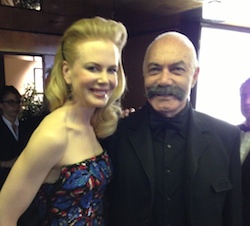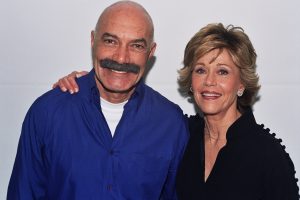
When AMPAS finally opened the doors in September, many industry leaders and donors were shocked at the lack of representation of the town’s Jewish immigrant pioneers. Amid cries of “intellectual dishonesty,” insiders reveal what happened (“overcorrection due to wokeness”) and plans to make good.
“If you’re going to have a museum in Los Angeles tied to the Academy that celebrates arguably the most significant art form of the 20th century, how is it possible not to acknowledge the Jewish men who started it all?” asks Goldwyn, ticking off names like Universal’s Carl Laemmle, Columbia’s Harry Cohn, Paramount’s Adolph Zukor and the brothers Warner. “It’s an egregious oversight.”

Where Are the Jews?
In 2018, the museum announced a permanent exhibition plan, under then-head Kerry Brougher. It included a gallery dedicated to the arc of the studio system and its founders. But his replacement Bill Kramer says that “we moved away from a chronological walk-through of cinematic history” in favor of a more thematic approach when he took over. “So many things were looked at in different ways in terms of, ‘How do we knit this all together?’ ”
Others believe the reconceived format was cover for new cultural storehouse wishing to position itself, post-George Floyd, to best avoid criticism over Hollywood’s own racism. Says one museum insider, “There has been a huge overcorrection of film history due to wokeness.”
Discrimination: Racial and/or Intellectual
Rabbi Marvin Hier, founder and CEO of the Simon Wiesenthal Center, which runs L.A.’s Museum of Tolerance, and himself a two-time Oscar winner (1982’s Genocide and 1997’s The Long Way Home), contends that to inaugurate an institution canonizing the film business in the absence of those who created it “is a form of intellectual discrimination.
Without the Jewish leadership in Hollywood, there would be no Hollywood.
The founding moguls, Ashkenazi Jews, created what became the film industry in part because they were excluded, both formally and informally, from what were then more prestigious commercial sectors, like finance.
“You could have an accent” in the nascent film industry, explains Sharon Pucker Rivo, exec director of the National Center for Jewish Film at Brandeis University. “It was wide open.”

Today, due to assimilation, the moguls’ descendants typically are considered white, and even the once-pervasive professional Anglicization of stage names — still in evidence among Winona Ryder (née Horowitz) and Natalie Portman (Hershlag) — has faded in younger generations. But this was not the world the founders inhabited.
Since Hollywood’s beginning, antisemites have blamed Jews for moral corruption to political subversion, according to Neal Gabler’s volume on the moguls, An Empire of Their Own. A core charge was that their otherness — advanced through the new technology of motion pictures and the fiefdoms they’d built to harness it — undermined traditional American values.
The consistent xenophobic assault on a group anxious about its own precarious position shaped the industry’s leadership. A reactionary conservatism prevailed among many of the moguls. They proactively implemented the Motion Picture Production Code, a puritanical set of guidelines that not only put limits on sex, skin and violence but also symbolism or storylines that it deemed anti-patriotic or amoral.
Later, they’d release the Waldorf Statement, which blacklisted the so-called Hollywood Ten — producers, directors and screenwriters who refused to answer questions regarding their political affiliations before the House Un-American Activities Committee. A candid assessment of Hollywood’s Jewish founders must tangle with this record, along with their more personal failings. It may be tsuris for a museum already in the crosshairs of many Jewish donors.


Overlooking the moguls’ story is troublingly ahistorical, say scholars.
“It’s the ultimate irony that this idealized, almost utopia-like portrait of America was created onscreen and perpetuated by a handful of impoverished Jewish immigrants,” says film historian Leonard Maltin.
Adds J. Hoberman, author of a volume on Jewish contributions to film, Entertaining America: “There’s a reason why MGM founder] Louis B. Mayer claimed his birthday was July 4th.”
Oscar-winning documentarian Richard Trank, who oversees content at the Museum of Tolerance, remarks that “the Hollywood Jews kept a low profile about their Jewishness. You had very few films — Gentleman’s Agreement, Judgment at Nuremberg, The Pawnbroker — and it really wasn’t until Schindler’s List in the ’90s that the motion picture industry came around.”

The museum, whose official messaging touts desire to be “radically inclusive,” since has acknowledged it has erred in omitting the Jewish founders.
The temporary opening exhibits include established names like Spike Lee and Almodóvar, pioneering Black director Oscar Micheaux, female editor Thelma Schoonmaker and martial arts master Bruce Lee.
The institution emphasizes that Jewishness has been woven into its curatorial activity since the opening, a symposium on Austrian exiles like Billy Wilder, which began at the end of 2021,
There are also moments throughout the collection on display, including an animated clip from 1986’s An American Tail, about a family of Jewish mice escaping a pogrom. But they are just moments.
A prominent sign in one hallway recognizing donor Barbra Streisand as the first woman to direct, produce, write and star in a major studio film, 1983’s Yentl, notes that she “redefined beauty standards” but doesn’t mention her Jewishness.

For me, the outcry was a lesson,” says Jacqueline Stewart, chief artistic officer. “It’s an acknowledgment of the really high expectations of us as an institution.”
In response, she and Kramer describe a previously planned temporary exhibit about the founders, “Hollywoodland,” is now being reconceived as permanent, scheduled to debut in spring 2023.
“Hollywoodland, will be a broad exploration of the birth of the studio system. Its curator Dara Jaffe says the pioneers’ backgrounds will inform the exhibit. “They were creating their own American dream, as they were creating Hollywood’s American dream.”
Source: Hollywood Reporter, Variety, AMPAS










